(Image credits: Pexels)
Creativity has driven human innovation since the beginning of time and continues to evolve along with us. From as early as the Stone Age, humans expressed themselves through the creation of art like the Montespan Cave drawings found in France (“Cave Art”). The invention of the clay tablet in Sumer and subsequently Egyptian papyrus paper revolutionized creativity in their times, allowing humans to pursue their passions and dive into their imaginations in all new ways. In the Renaissance, artists such as Leonardo da Vinci showed that one could be both creative and a genius with his paintings like the Mona Lisa and his flying machines. The invention of the computer, in a similar fashion, sparked a transformation in human creative capability. Charles Babbage’s Difference Machine of the 1800s holds the title of the first computing machine (“Difference Engine”), while Alan Turing’s 1936 paper On Computable Numbers set the basis for modern computing technology (“Turing On Computable Numbers”). However, the first automatic electronic digital computer, the Atanasoff-Berry or ABC Computer, would not enter the scene until 1942 (“Atanasoff-Berry Computer”). Computers brought about an entirely new world of possibilities. Before too long, scientists began to wonder: what would happen if they combined traditional modes of creation with new technology? The answer is the art tablet.
The art tablet, also known as graphics tablets, drawing tablets, pen tablets, digitizer tablets, and more, is a device that allows for the input of information into a computer and the creation of drawings, handwriting, and other creative elements. Today, digital tablets with smooth surfaces rule the industry, but that was not always the case. Art tablets have almost constantly changed since their first ancestor of the 19th century, and their evolution has transformed both the technological world and the ways in which we make art.
The Pantelegraph

(Image credits: FaxAuthority)
The first tablet ancestor and attempt at creative and technological combination takes us back to the 1860s and a man named Giovanni Caselli (“The Original Scanner”). Together with the help of Paul Gustave Froment, he created a machine he dubbed the Pantelegraph, a two-meters tall device that became the first practical device capable of sending messages and drawings (“What is a Pantelegraph?”). To begin the process of sending a message, the sender would write a non-conducting ink message on a sheet of tin, then secure it to the machine which would move a stylus across the image. The scanned image was then sent to a telegraph to be recreated on a potassium ferrocyanide soaked paper (“The Original Scanner”). The Pantelegraph proved popular with over 5,000 messages sent within its first year, as well as impressing both Napoleon III and King Victor Emmanuel II (“The Original Scanner”). It was both a success on its own and in the name of image-processing technology, paving the way for more digitizing breakthroughs.
Yet as with most fame, its popularity died quickly. The device had many problems, such as the recreations being hard to make out and trouble keeping the sender and receiver in sync (“The Original Scanner”). In the end, Caselli passed the torch to the Chinese Empire to continue advancing the device, but not much happened with these experiments until Japan began their own (“The Original Scanner”). Thus ended the Pantelegraph revolution.
The Telautograph
(Image credits: Unknown, WikiCommons)
In 1895, a similar yet superior device emerged by a man named Elisha Gray. He called it the Telautograph, a device used to read and recreate both sketches and handwriting (Curley, “TelAutograph”). The Telautograph consisted of both a transmitter and a receiver. The sender would create the image at the transmitter, which converted the stylus motion into electrical signals and then sent those signals to the receiver to be recreated (Curley, “TelAutograph”). This machine evolved over the years and eventually led to the creation of the fax machine (“What is a Telautograph?”), but also contributed to the future of digitizing.
The Stylator
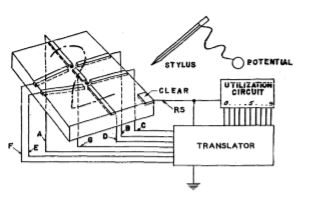
(Image credits: Dimond, T.L.)
The Stylator, meaning stylus translator or interpreter, was the next major breakthrough in digitizing technology after its creation by T.L. Dimond in 1957 (“Reading Handwritten Characters”). The machine consisted of a plastic surface with seven embedded conductors that surround a writing surface with two guide dots, a stylus connected to a source of potential energy, and a translator. The user would write a character using the guide dots as the stylus energized the conductors in the involved areas one at a time, which would, in turn, cause a flip-flop in the translator circuit to indicate the correct numeral (“Reading Handwritten Characters”). Put it all together, and you get the first true digitizing tablet.
This tablet, capable of connecting to phones, teletypewriters, and numeral readers, had about as many applications as it had problems. First of all, it couldn’t read another new numeral until the translator circuit was manually returned to normal after the completion of the previous numeral (“Reading Handwritten Characters”). This meant that a writer had to repetitively write a single numeral and reset the tablet. Second, it could only recreate and read characters it recognized (“Reading Handwritten Characters”). This meant that it had limited creative output since one could not draw freehanded. And if that wasn’t enough, those limited characters could only have specific shapes as defined by the guide dots (“Reading Handwritten Characters”). So even though the Stylator stands as the first digitizing tablet, it falls far from our modern definition of digitizing tablets.
The RAND Tablet
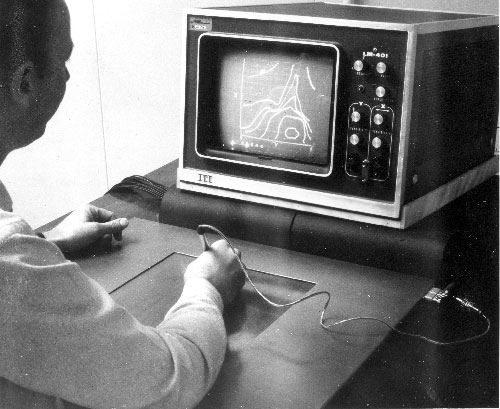
(Image credits: Gwen Bell, Computer History Museum)
After the Stylator, the next important invention in graphics tablet history was the 1963 RAND Tablet. While the Stylator was the first digitizing tablet, the RAND Tablet was the first digital graphics tablet in addition to being the first tablet to work real time and allow the writer to use natural handwriting (Davis and Ellis p. v). The tablet itself had a resolution of 100 lines per inch, connected to a computer and oscilloscope display, and contained a writing surface with an X and Y axis (p. 1). The oscilloscope displayed the current pen position and the computer output by receiving computer-generated information and stylus position information together from the display control (p. 3). Another important feature to note is the tip of the stylus. The stylus tip, containing a pressure-sensitive switch actuated by relatively the same pressure as writing with a real pencil, could input information into the computer in order for it to read the motion as a natural stroke (p. 3). This innovation is critical and perhaps the RAND Tablet’s most important contribution to art tablet history because it is considered a standard for today’s graphics tablets.
The BitPad
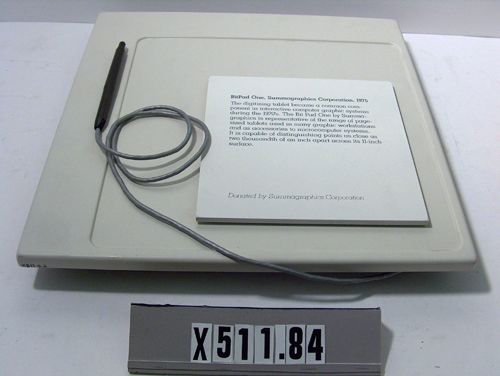
(Image credits: Computer History Museum)
Next in line stands the 1975 Summagraphics Corp. BitPad, the first tablet to resemble modern day graphics tablets. This small and comfortable design helped popularize graphics tablets to a larger market. The machine itself, consisting of a digitizer board, stylus, and power connector, digitized real-time data into machine-readable form while operating on magnetostrictive principles. The tablet contained a mesh underneath the writing plane that would change dimensions from current pulses and send strain waves down the axis wires to receiving coils in the stylus, which were then counted and converted into X and Y coordinate data (Bit Pad Manual, p. 4). With its small design and unique operating method, the tablet had many applications. However, it still wasn’t a true graphics tablet, as it didn’t necessarily run on a graphics system.
The Apple Graphics Tablets
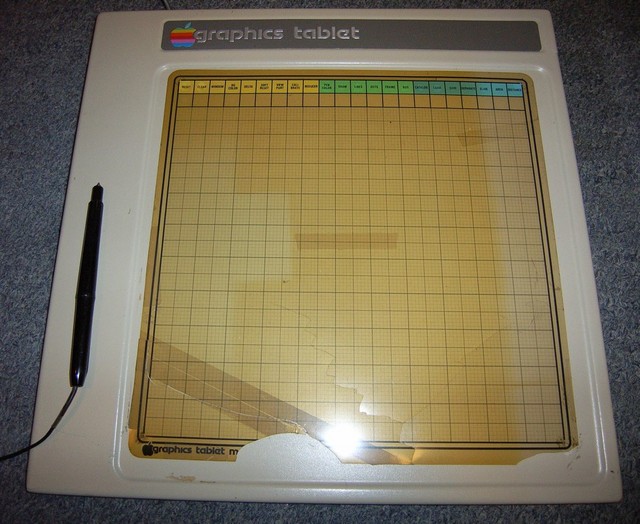
(Image credits: Edible Apple)
But even though the BitPad didn’t run on a graphics system, the Apple Graphics Tablets of 1979 did. The grid-surfaced tablet that connected to the Apple II Plus desktop ran on the Utopia Graphics System, which told the computer how to interpret the pen’s motion (Graphics Tablet Manual, p. 1). This allowed for many creative applications like art and design, but it wasn’t perfect. For instance, its earlier versions interfered with radio frequencies and had to be redesigned. (“First Apple Tablet”) This device began Apple’s venture into tablet technology, and it definitely set the stage for further exploring by the corporation.
The KoalaPad
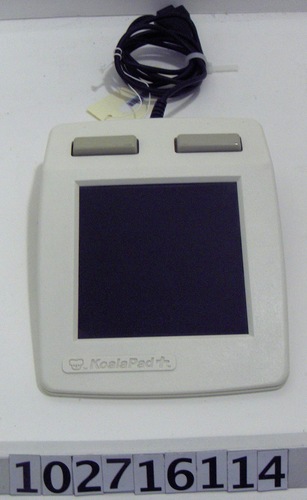
(Image credits: Computer History Museum)
In 1984, Koala Technologies released the KoalaPad. It was both the first tablet to use touch technology and draw in color, with the simple machine containing a pressure-sensitive area, two buttons, and a paddle or joystick connector (Thornburg, p. 7). This tablet’s applications included — but was not limited to — artistry, education, video game creation, and music creation. Although its application variety and computing capabilities for its time remain impressive, few people today remember the KoalaPad.
The Wacom WT Series
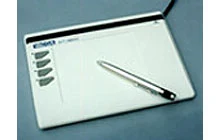
(Image credits: Wacom)
Unlike the KoalaPad, people do remember the Wacom WT series that launched in the same year. Even though it was relatively simple, it utilized the first wireless stylus in the market (“Company History”). This tablet series stands as the first created by Wacom Corporation, a Japanese company that leads today’s art tablet industry.
The GRiDPad
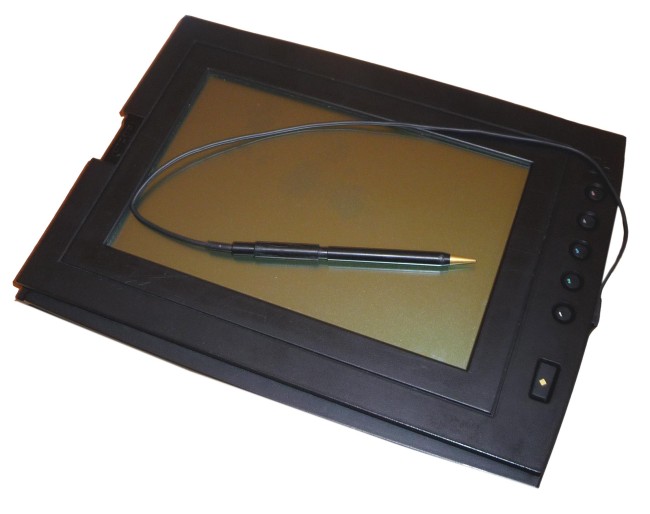
(Image credits: Centre for Computing History)
1989 saw the birth of GRiD Systems Corporation’s GRiDPad, also known as the first tablet computer (“GRiDPad”). The GRiDPad ran on the Microsoft MS-DOS 3.3 operating system, and although it was technically a graphics tablet, its primary usage pertained to inventory and military applications (“GRiDPad 1910”). However, it proved that a tablet could run on Microsoft operating systems.
The Microsoft Tablet PC and Windows XP Tablet Edition
(Image credits: Reuters, Jeff Christensen, Business Insider)
Here enters the Microsoft Tablet PC of 1999. Recognized as the first modern tablet PC, the Microsoft Tablet PC was meant originally meant to run on Microsoft Windows XP and only displayed in black and white (“Microsoft Tablet Before Apple”). Three years later, the Windows XP Tablet Edition of 2002 remedies these problems, now operating on the intended system and displaying in color (“Microsoft Tablet Before Apple”). This tablet introduced the concept of tablets we now hold and the technology to create them.
The Bamboo
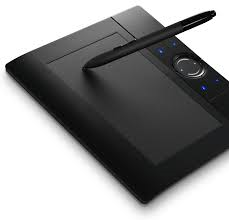
(Image credits: Wacom)
Wacom, steadily releasing new tablet designs since the WT series, came back in 2007 with the Bamboo line of tablets. Capable of working with Windows Vista and Mac OS X 10.3 and up, the Bamboo utilized over 500 levels of pressure sensitivity — an unheard of number at that time (“Wacom Bamboo”). Furthermore, it bridged the gap between high end and inexpensive graphics tablets (“Wacom Bamboo”). The tablet, although capable of creating art, was mostly used to replace a mouse and streamline workflow because of its small size (“Wacom Bamboo”).
The iPad
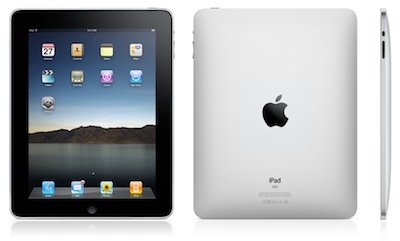
(Image credits: Apple Inc., Apple-History)
The Apple iPad of 2010 stands as one of the greatest tablets of all time and is arguably what brought tablets into the mainstream. Unlike the Microsoft Tablet PC and Windows Tablet Edition, the iPad ran on an operating system specifically designed for tablets, and an update shortly after its release allowed for the now-famous multitasking (“Evolution of the iPad”). Because of creative apps and the iPad’s sleek, portable design, artists could now create wherever they went.
The Cintiq 24hd
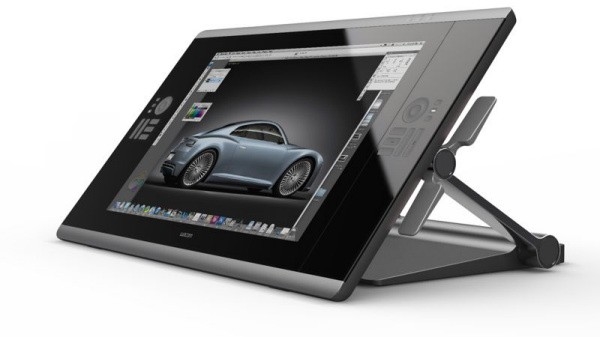
(Image credits: Wacom)
Only a year later in 2011, Wacom delivered with the Cintiq 24hd. This design developed what we now see as the face of modern graphics tablets. Meant primarily for creative professionals, the Cintiq 24hd contains a whopping 2,048 levels of pressure sensitivity, wireless stylus, and a built-in monitor (“Largest Cintiq Yet”). It used the most cutting-edge creative technology up to that point, firmly establishing Wacom as the leader in the art tablet industry.
Today and the Cintiq Pro
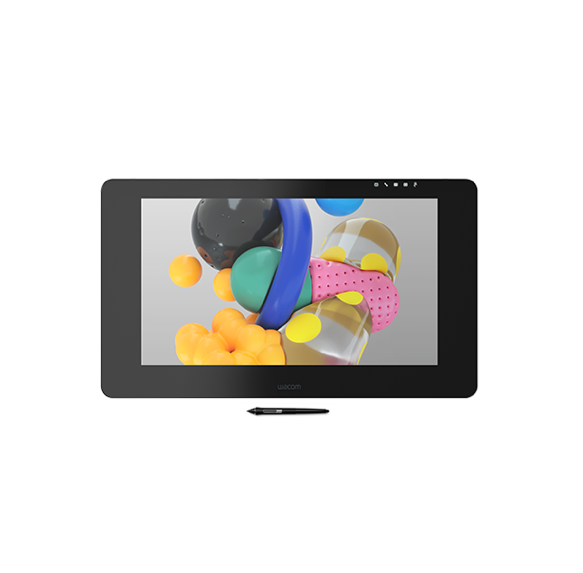
(Image credits: Wacom)
Now, here we are today with the release of the Wacom Cintiq Pro 24-inch Pen Display. In essence, it embodies the portability of the iPad with the creative power of the Cintiq 24hd — and then some. It boasts a staggering 8,192 levels of pressure sensitivity, 4k resolution, and 98% Adobe RGB color accuracy (“Wacom introduces Cintiq Pro 24-inch”). Most impressively, it gives us a glimpse into the future. This tablet leads the way into augmented and virtual reality capabilities for tablets (“Wacom introduces Cintiq Pro 24-inch”). This tablet just released this year, leaving us to wonder what Wacom will release next.
The Future?
The modern art tablet brings together the best of art and computer technology, pulling from concepts and inventions dating back since the beginning of time. From its beginnings with the Pantelegraph of the 1860s to the modern Wacom Cintiq Pro, the digitizing technology is barely recognizable. So if it has changed from pendulums to virtual reality, what direction will it take in the future?
I believe the future lies in what we are bringing into the present. As we see with the Cintiq Pro, virtual and augmented reality dominate the today’s technological advances. How about a step further? I see the future of graphics tablets eliminating the tablet completely. In recent years, scientists work on creating styluses capable of writing midair through use of sensors. One day, we might not even need the stylus and be able to draw just by a sensor reading the movement of our hands. The only limit to the graphics tablet is our own imagination.
References
- “Pantelegraph – the Original Scanner.” Record Nations, http://www.recordnations.com/articles/pantelegraph/
- “What Is a Pantelegraph (Invented by Giovanni Caselli)?”. FaxAuthority, Updated 30 Aug. 2018, https://faxauthority.com/glossary/pantelegraph/
- Curley, Robert. “TelAutograph”. Encyclopedia Britannica, 18 Feb.
2009, https://www.britannica.com/technology/TelAutograph - “What is a Telautograph (Invented by Elisha Gray)?”. FaxAuthority, Updated 30 August 2018, https://faxauthority.com/glossary/telautograph/
- Dimond, T.L. (1957). Devices for Reading Handwritten Characters, Proceedings of the Eastern Computer Conference, pp. 232 – 237.
- Buxton, Bill. “Some Milestones in Computer Input Devices:
An Informal Timeline”, Published 18 Feb. 2011. https://www.billbuxton.com/inputTimeline.html - HistoryofInformation.com, “The Rand Tablet: One of the Earliest Tablet Computers and the First Reference to Electronic Ink.” http://www.historyofinformation.com/expanded.php?id=2826
- Davis, M.R., and T.O. Ellis. The RAND Tablet: A Man-Machine Graphical Communication Device. RAND Corporation, 1964, pp. iii – 3.
- Bit Pad One Users Manual. Summagraphics Corporation, 1979. Internet Archive, p. 4, https://archive.org/details/bitsavers_sumagraphiualAug81_2395058/page/n9
- “Summagraphics Bit Pad One.” Centre for Computing History, http://www.computinghistory.org.uk/det/16811/Summagraphics-Bit-Pad-One/
- “The first Apple Tablet… from 1979.” Apple History, News, Edible Apple, 23 Nov 2009, http://www.edibleapple.com/2009/11/23/the-first-apple-tablet-from-1979/
- Graphics Tablet Operation and Reference Manual, Apple Computer Inc., 1979. p. 1.
- O’Hara, Rob. “The KoalaPad.” Computers. The Retroist, 23 Jan. 2012, https://www.retroist.com/2012/01/23/the-koalapad/
- Thornburg, David D. “I. What is the KoalaPad and What Makes it useful?” The KoalaPad Book, Addison-Wesley Publishing Company, 1984, pp. 1 – 8
- Wacom, “Company History”, http://www.wacom.jp/en/company/history/
- Centre for Computing History, “GRiDPad 1910”, http://www.computinghistory.org.uk/det/6565/gridpad-1910/
- “GRiDPad.” oldcomputers.net, http://oldcomputers.net/gridpad.html
- Bort, Julie. “Microsoft Invented A Tablet A Decade Before Apple And Totally Blew It”, 30 May 2013, Business Insider, https://www.businessinsider.com/heres-visual-proof-of-just-how-badly-microsoft-blew-it-with-tablets-2013-5
- Gralla, Preston. “Microsoft released its first tablet 10 years ago. So why did Apple win with the iPad?”. Seeing Through Windows, Computerworld, 10 Nov. 2011, https://www.computerworld.com/article/2471642/mobile-apps/microsoft-released-its-first-tablet-10-years-ago–so-why-did-apple-win-with-the-ipad-.html
- Beschizza, Robert. “Wacom Bamboo Tablet To Make Mincemeat of Mice?”. Wired, 15 May 2007, https://www.wired.com/2007/05/wacom-bamboo-ta/
- Nations, Daniel. “The History and Evolution of the iPad”, Updated 21 May 2018. Lifewire. https://www.lifewire.com/history-of-the-ipad-1994668
- Caldwell, Serenity. “Wacom announces its largest Cintiq yet, the 24HD”. News, Macworld, 13 Sep 2011, https://www.macworld.com/article/1162247/wacom_announces_its_largest_cintiq_yet_the_24hd.html
- “Wacom introduces the Cintiq Pro 24-inch pen display”. News and Events, Wacom, 27 Feb 2018, https://www.wacom.com/en-us/about-wacom/news-and-events/2018/1285
- Clottes, Jean. “Cave Art.” Encyclopedia Britannica, 6 March 2015, https://www.britannica.com/art/cave-painting
- Swaine, Michael R. Freiberger, Paul A. “Difference Engine.” Encyclopedia Britannica, 7 October 2008, https://www.britannica.com/technology/Difference-Engine
- Norman, Jeremy. “Alan Turing Publishes “On Computable Numbers,” Describing What Came to be Called the “Turing Machine”.” HistoryofInformation.com, Updated 31 December 2014, http://www.historyofinformation.com/expanded.php?id=735
- Freiberger, Paul A. Swaine, Michael R. “Atanasoff-Berry Computer.” Encyclopedia Britannica, 7 October 2008, https://www.britannica.com/technology/Atanasoff-Berry-Computer
Image Credits
- stevepb. Pixabay, https://pixabay.com/en/graphics-tablet-wacom-photoshop-1964816/
- Pantelegraph. FaxAuthority, https://faxauthority.com/glossary/pantelegraph/
- Telautograph Transmitter. WikiCommons, link
- Telautograph Receiver. WikiCommons, link
- Dimond, T.L. Stylator. Devices for Reading Handwritten Characters, Proceedings of the Eastern Computer Conference. 1957. Print.
- Bell, Gwen. RAND Tablet. Computer History, Museum.http://www.computerhistory.org/collections/catalog/102630782
- BitPad. Computer History, Museum, http://www.computerhistory.org/collections/catalog/102710374
- Apple Graphics Tablet. Edible Apple, http://www.edibleapple.com/2009/11/23/the-first-apple-tablet-from-1979/
- Erhman, John. KoalaPad. Computer History Museum, http://www.computerhistory.org/collections/catalog/102716114
- Wacom WT-460m. Wacom. Company History, http://www.wacom.jp/en/company/history/
- GRiDPad. Centre for Computing History, http://www.computinghistory.org.uk/det/6565/gridpad-1910/
- Reuters. Bill Gates with a Microsoft tablet in 2000. Business Insider, https://www.businessinsider.com/heres-visual-proof-of-just-how-badly-microsoft-blew-it-with-tablets-2013-5
- Reuters, Christensen. Windows XP Tablet Edition. Business Insider, https://www.businessinsider.com/heres-visual-proof-of-just-how-badly-microsoft-blew-it-with-tablets-2013-5
- Bamboo. Wacom. User Manual for Windows and Macintosh. 2007. Print.
- iPad. Apple-History, https://apple-history.com/ipad
- Wacom Cintiq 24hd. Engaget, 9 December 2011, https://www.engadget.com/2011/09/12/wacom-cintiq-24hd-images-break-cover-we-start-practicing-our-st/
- Wacom Cintiq Pro 24″. Wacom. Wacom Cintiq Pro, https://www.wacom.com/en-es/products/pen-displays/wacom-cintiq-pro-24



